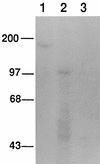Stable transfection of Trypanosoma cruzi epimastigotes with the trypomastigote-specific complement regulatory protein cDNA confers complement resistance
- PMID: 9596703
- PMCID: PMC108225
- DOI: 10.1128/IAI.66.6.2460-2465.1998
Stable transfection of Trypanosoma cruzi epimastigotes with the trypomastigote-specific complement regulatory protein cDNA confers complement resistance
Abstract
Trypanosoma cruzi blood stage trypomastigotes are highly resistant to complement-mediated killing in normal serum. A previously described trypomastigote surface glycoprotein was shown to have binding affinity for human complement components C3b and C4b and restrict activation of the complement cascade, thus preventing lysis of the parasites. Insect stage epimastigotes do not produce detectable levels of this 160-kDa complement regulatory protein (CRP) and are highly sensitive to the lytic effects of complement. Epimastigotes were stably transfected with a T. cruzi expression vector carrying the trypomastigote CRP cDNA and produced fully functional recombinant CRP. The recombinant CRP had binding affinity for C3b, and the transfected epimastigotes were protected from complement-mediated lysis. These results demonstrate for the first time that a developmentally regulated gene of T. cruzi trypomastigotes can be expressed in noninfectious epimastigotes and that production of CRP by epimastigotes is sufficient to confer a virulence-associated trait. Furthermore, these studies demonstrate the critical role that trypomastigote CRP plays in the protection of parasites from the deleterious effects of complement, thus establishing the protein as a virulence factor of T. cruzi.
Figures




Similar articles
-
Ligand-binding renders the 160 kDa Trypanosoma cruzi complement regulatory protein susceptible to proteolytic cleavage.Microb Pathog. 1996 Oct;21(4):235-48. doi: 10.1006/mpat.1996.0058. Microb Pathog. 1996. PMID: 8905613
-
Identification of the gene family encoding the 160-kilodalton Trypanosoma cruzi complement regulatory protein.Infect Immun. 1997 Feb;65(2):349-57. doi: 10.1128/iai.65.2.349-357.1997. Infect Immun. 1997. PMID: 9009282 Free PMC article.
-
Expression and purification of functional, recombinant Trypanosoma cruzi complement regulatory protein.Protein Expr Purif. 2003 Jan;27(1):19-26. doi: 10.1016/s1046-5928(02)00562-4. Protein Expr Purif. 2003. PMID: 12509980
-
Trypanosoma cruzi Evades the Complement System as an Efficient Strategy to Survive in the Mammalian Host: The Specific Roles of Host/Parasite Molecules and Trypanosoma cruzi Calreticulin.Front Microbiol. 2017 Sep 1;8:1667. doi: 10.3389/fmicb.2017.01667. eCollection 2017. Front Microbiol. 2017. PMID: 28919885 Free PMC article. Review.
-
Developmentally-regulated virulence factors of Trypanosoma cruzi and their relationship to evasion of host defences.J Eukaryot Microbiol. 1993 Mar-Apr;40(2):207-13. doi: 10.1111/j.1550-7408.1993.tb04905.x. J Eukaryot Microbiol. 1993. PMID: 8461894 Review.
Cited by
-
The emerging role of complement lectin pathway in trypanosomatids: molecular bases in activation, genetic deficiencies, susceptibility to infection, and complement system-based therapeutics.ScientificWorldJournal. 2013;2013:675898. doi: 10.1155/2013/675898. Epub 2013 Feb 21. ScientificWorldJournal. 2013. PMID: 23533355 Free PMC article. Review.
-
Emulating interactions between microorganisms and tumor microenvironment to develop cancer theranostics.Theranostics. 2022 Mar 14;12(6):2833-2859. doi: 10.7150/thno.70719. eCollection 2022. Theranostics. 2022. PMID: 35401838 Free PMC article. Review.
-
An induced population of Trypanosoma cruzi epimastigotes more resistant to complement lysis promotes a phenotype with greater differentiation, invasiveness, and release of extracellular vesicles.Front Cell Infect Microbiol. 2022 Dec 14;12:1046681. doi: 10.3389/fcimb.2022.1046681. eCollection 2022. Front Cell Infect Microbiol. 2022. PMID: 36590580 Free PMC article.
-
Impact of the Extracellular Vesicles Derived From Trypanosoma cruzi: A Paradox in Host Response and Lipid Metabolism Modulation.Front Cell Infect Microbiol. 2021 Oct 28;11:768124. doi: 10.3389/fcimb.2021.768124. eCollection 2021. Front Cell Infect Microbiol. 2021. PMID: 34778110 Free PMC article. Review.
-
Proteome analysis of Plasmodium falciparum extracellular secretory antigens at asexual blood stages reveals a cohort of proteins with possible roles in immune modulation and signaling.Mol Cell Proteomics. 2009 Sep;8(9):2102-18. doi: 10.1074/mcp.M900029-MCP200. Epub 2009 Jun 3. Mol Cell Proteomics. 2009. PMID: 19494339 Free PMC article.
References
-
- Galvão, L., and K. Norris. Unpublished data.
-
- Joiner K, Dias da Silva W, Rimoldi M, Hammer C, Sher A, Kipnis T. Biochemical characterization of a factor produced by trypomastigotes of Trypanosoma cruzi that accelerates the decay of complement C3 convertases. J Biol Chem. 1988;263:11327–11335. - PubMed
Publication types
MeSH terms
Substances
Grants and funding
LinkOut - more resources
Full Text Sources
Other Literature Sources
Research Materials
Miscellaneous

